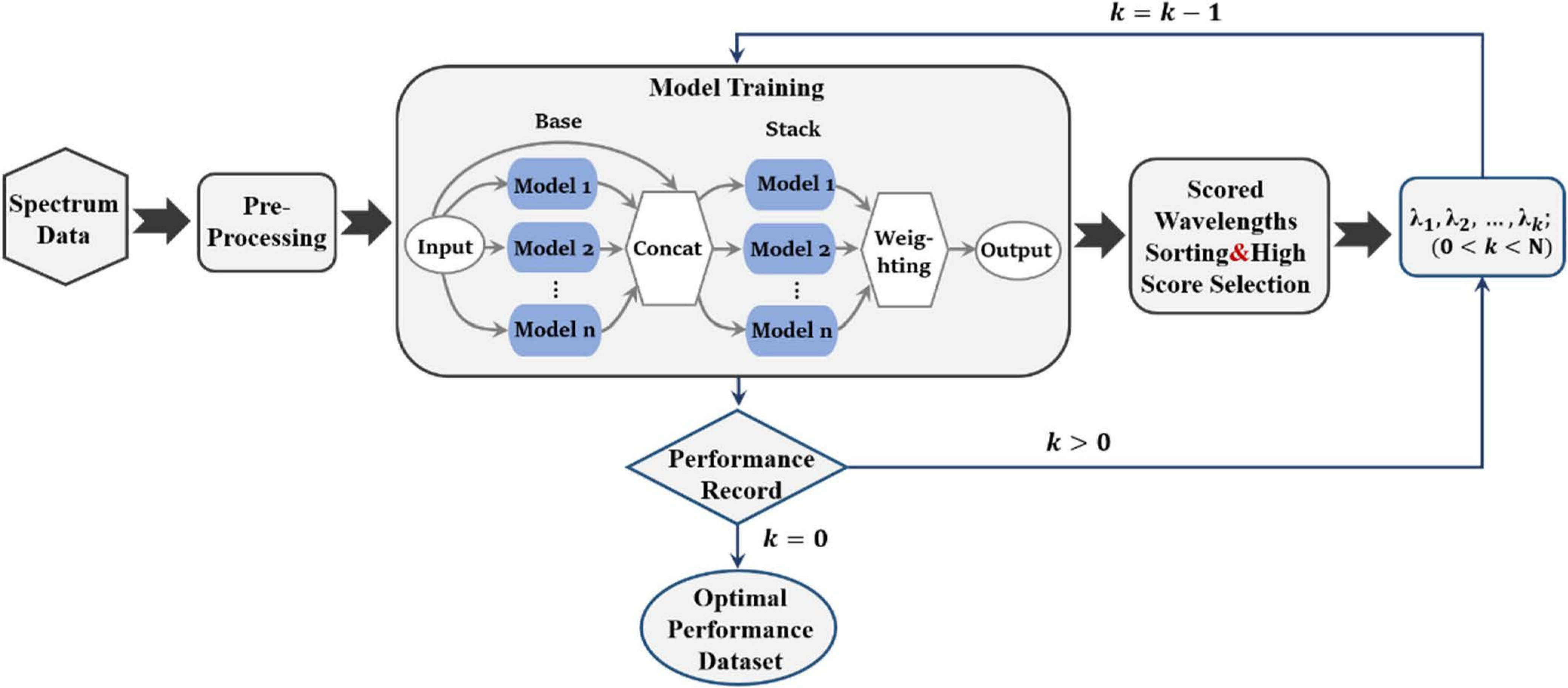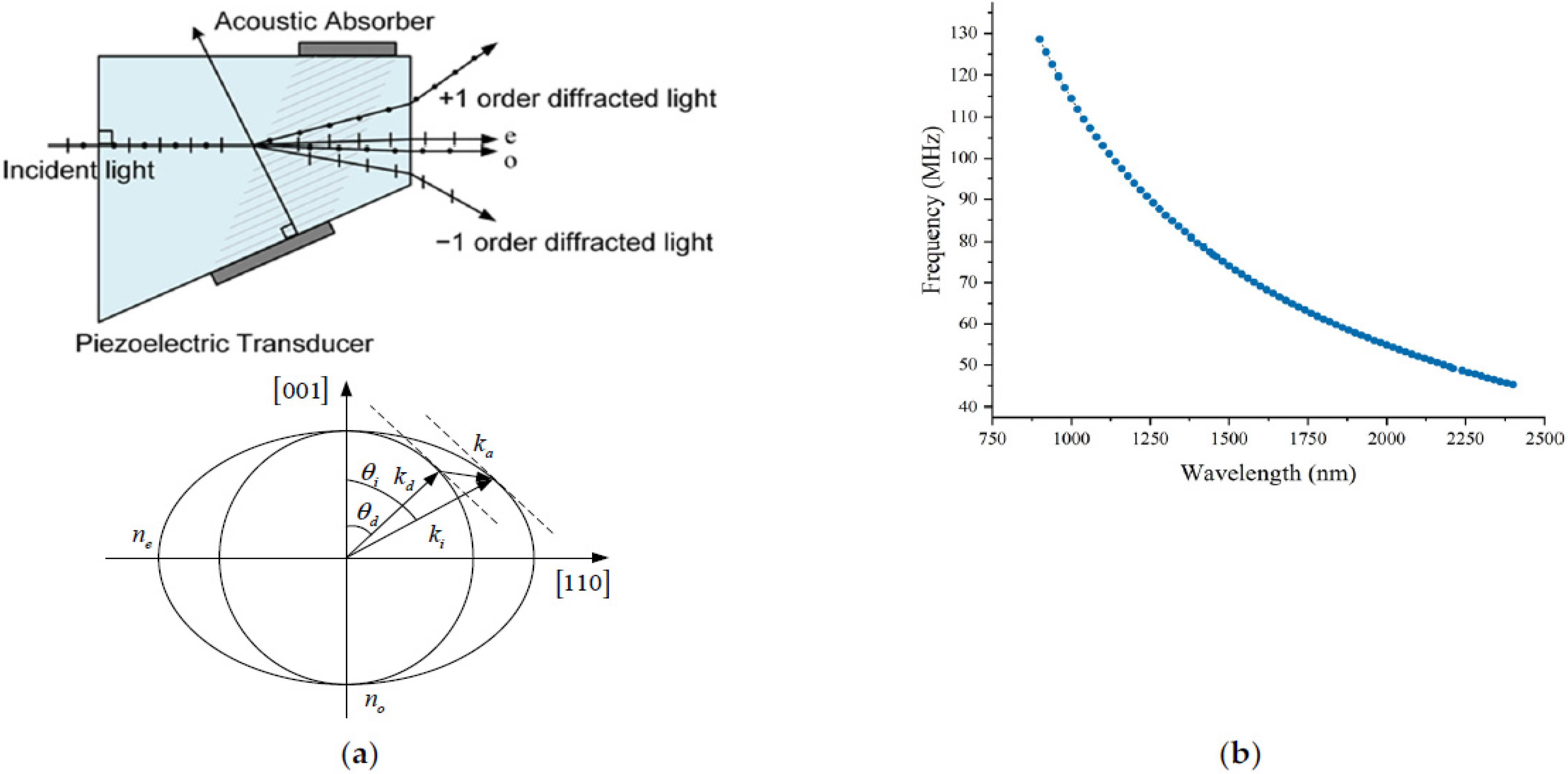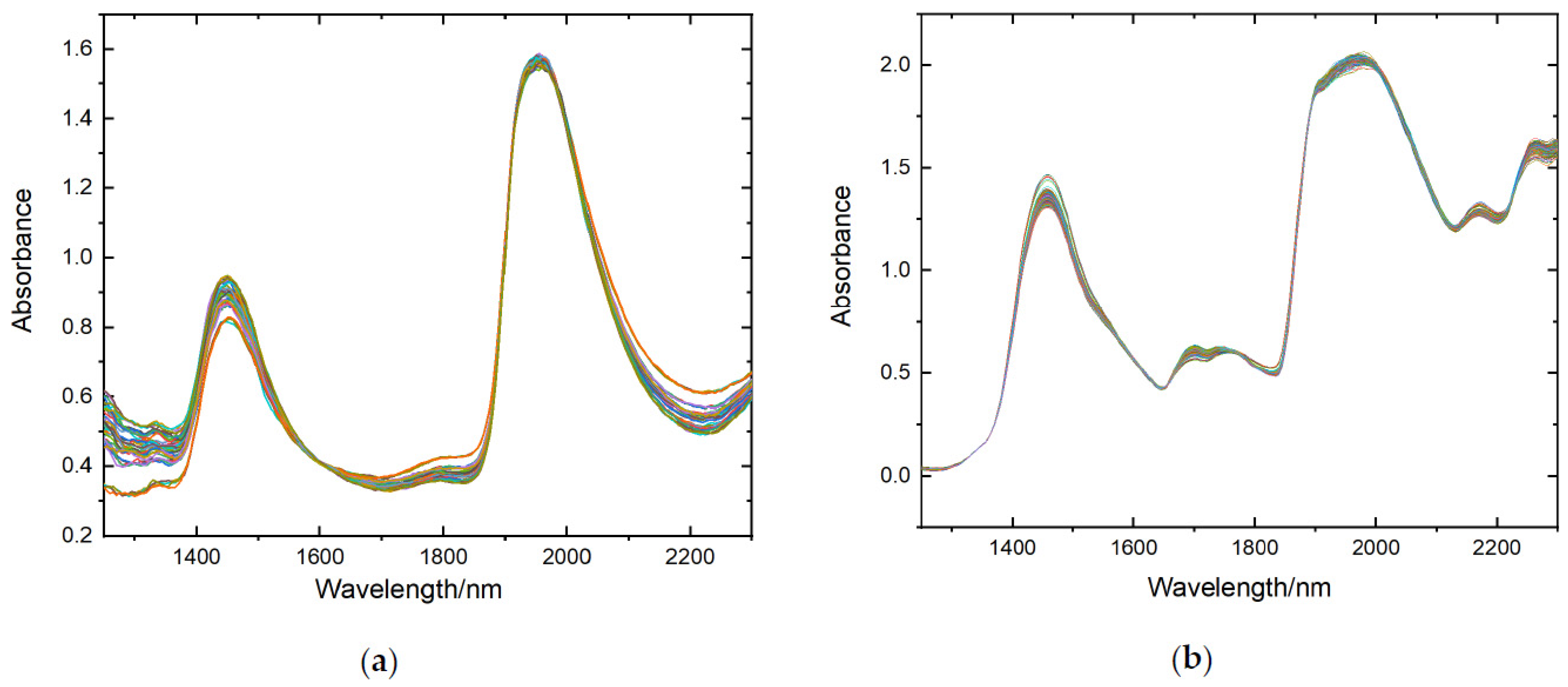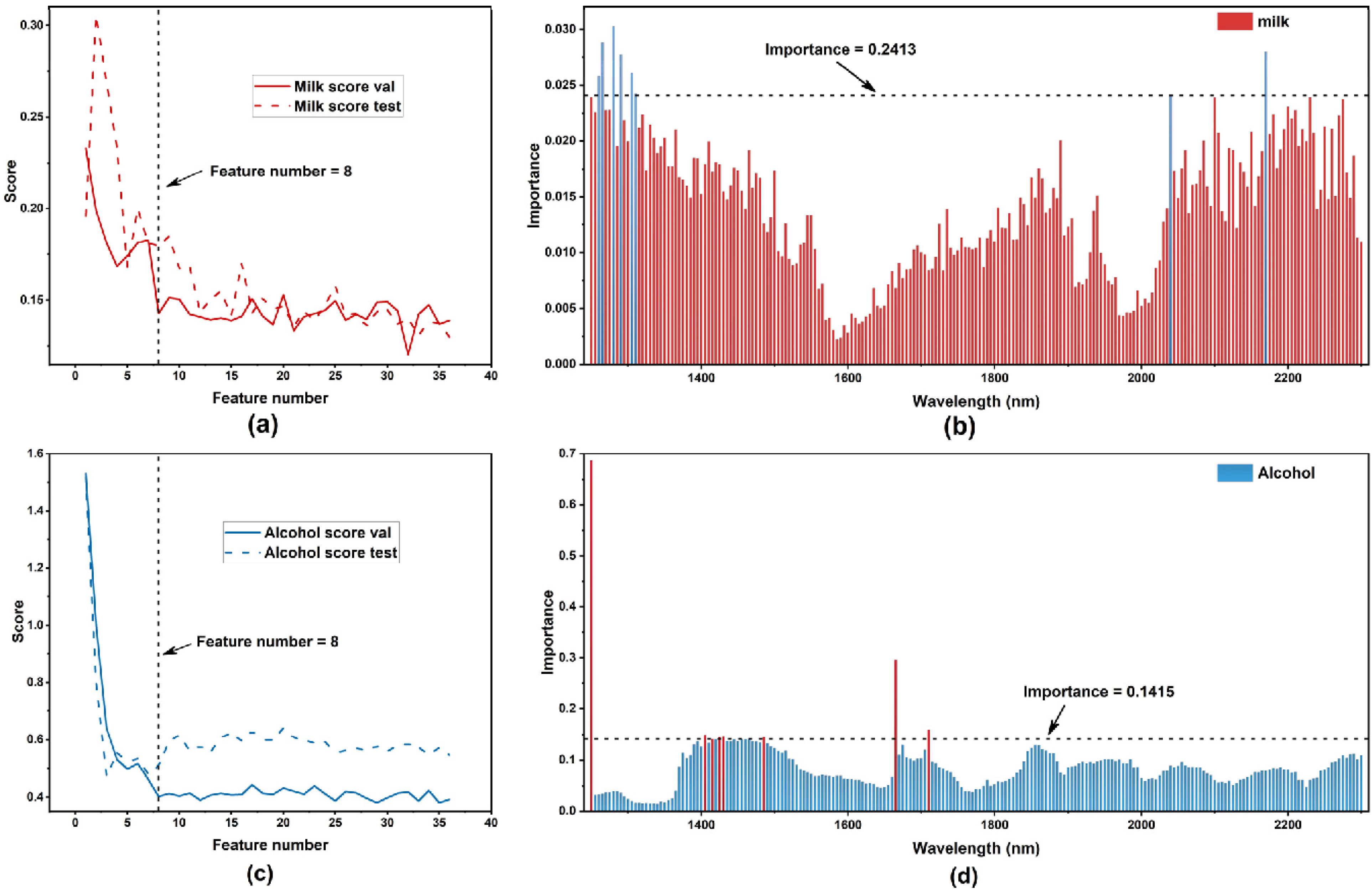Research and Application Validation of a Feature Wavelength Selection Method Based on Acousto-Optic Tunable Filter (AOTF) and Automatic Machine Learning (AutoML)
Abstract
:1. Introduction
2. AutoML-Based Feature Wavelength Selection
- (1)
- Data pre-processing
- (2)
- Model training
- (3)
- Wavelength importance ranking
- (4)
- Feature wavelength combination screening
3. Instrument Design and Working Principle
4. Application Results
4.1. Sample Preparation
4.2. Modeling and Feature Wavelength Selection
4.3. Experimental Results of the System
5. Conclusions
Author Contributions
Funding
Institutional Review Board Statement
Informed Consent Statement
Data Availability Statement
Conflicts of Interest
References
- Osborne, B.G. Near-infrared spectroscopy in food analysis. In Encyclopedia of Analytical Chemistry: Applications, Theory and Instrumentation; BRI Australia Ltd.: North Ryde, NSW, Australia, 2006. [Google Scholar]
- Pu, H.; Kamruzzaman, M.; Sun, D.-W. Selection of feature wavelengths for developing multispectral imaging systems for quality, safety and authenticity of muscle foods-a review. Trends Food Sci. Technol. 2015, 45, 86–104. [Google Scholar] [CrossRef]
- Scafi, S.H.F.; Pasquini, C. Identification of counterfeit drugs using near-infrared spectroscopy. Analyst 2001, 126, 2218–2224. [Google Scholar] [CrossRef] [PubMed] [Green Version]
- Wang, D.-J.; Zhou, X.-Y.; Jin, T.-M.; Hu, X.; Zhong, J.; Wu, Q. Application of near-infrared spectroscopy to agriculture and food analysis. Guang Pu Xue Yu Guang Pu Fen Xi = Guang Pu 2004, 24, 447–450. [Google Scholar]
- Yang, J.; Li, J.; Hu, J.; Yang, W.; Zhang, X.; Xu, J.; Zhang, Y.; Luo, X.; Ting, K.C.; Lin, T.; et al. An interpretable deep learning approach for calibration transfer among multiple near-infrared instruments. Comput. Electron. Agric. 2022, 192, 106584. [Google Scholar] [CrossRef]
- Lorente, D.; Aleixos, N.; Gómez-Sanchis, J.; Cubero, S.; Blasco, J. Selection of optimal wavelength features for decay detection in citrus fruit using the ROC curve and neural networks. Food Bioprocess Technol. 2013, 6, 530–541. [Google Scholar] [CrossRef] [Green Version]
- Yun, Y.-H.; Li, H.-D.; Deng, B.-C.; Cao, D.-S. An overview of variable selection methods in multivariate analysis of near-infrared spectra. TrAC Trends Anal. Chem. 2019, 113, 102–115. [Google Scholar] [CrossRef]
- Li, H.; Liang, Y.; Xu, Q.; Cao, D. Key wavelengths screening using competitive adaptive reweighted sampling method for multivariate calibration. Anal. Chim. Acta 2009, 648, 77–84. [Google Scholar] [CrossRef]
- Li, H.-D.; Xu, Q.-S.; Liang, Y.-Z. Random frog: An efficient reversible jump Markov Chain Monte Carlo-like approach for variable selection with applications to gene selection and disease classification. Anal. Chim. Acta 2012, 740, 20–26. [Google Scholar] [CrossRef]
- Leardi, R.; Gonzalez, A.L. Genetic algorithms applied to feature selection in PLS regression: How and when to use them. Chemom. Intell. Lab. Syst. 1998, 41, 195–207. [Google Scholar] [CrossRef]
- Gijsbers, P.; LeDell, E.; Thomas, J.; Poirier, S.; Bischl, B.; Vanschoren, J. An Open Source AutoML Benchmark. arXiv 2019, arXiv:1907.00909. [Google Scholar]
- Amsaraj, R.; Mutturi, S. Real-coded GA coupled to PLS for rapid detection and quantification of tartrazine in tea using FT-IR spectroscopy. Lwt-Food Sci. Technol. 2021, 139, 8. [Google Scholar] [CrossRef]
- Holroyd, S.E. The use of near infrared spectroscopy on milk and milk products. J. Near Infrared Spectrosc. 2013, 21, 311–322. [Google Scholar] [CrossRef]
- Moscetti, R.; Raponi, F.; Ferri, S.; Colantoni, A.; Monarca, D.; Massantini, R. Real-time monitoring of organic apple (var. Gala) during hot-air drying using near-infrared spectroscopy. J. Food Eng. 2018, 222, 139–150. [Google Scholar] [CrossRef]
- Bellincontro, A.; Taticchi, A.; Servili, M.; Esposto, S.; Farinelli, D.; Mencarelli, F. Feasible application of a portable NIR-AOTF tool for on-field prediction of phenolic compounds during the ripening of olives for oil production. J. Agric. Food Chem. 2012, 60, 2665–2673. [Google Scholar] [CrossRef]
- Cirilli, M.; Bellincontro, A.; Urbani, S.; Servili, M.; Esposto, S.; Mencarelli, F.; Muleo, R. On-field monitoring of fruit ripening evolution and quality parameters in olive mutants using a portable NIR-AOTF device. Food Chem. 2016, 199, 96–104. [Google Scholar] [CrossRef]
- Fernández-Espinosa, A.J. Combining PLS regression with portable NIR spectroscopy to on-line monitor quality parameters in intact olives for determining optimal harvesting time. Talanta 2016, 148, 216–228. [Google Scholar] [CrossRef]
- Allouche, Y.; López, E.F.; Maza, G.B.; Márquez, A.J. Near infrared spectroscopy and artificial neural network to characterise olive fruit and oil online for process optimisation. J. Near Infrared Spectrosc. 2015, 23, 111–121. [Google Scholar] [CrossRef]
- Naganathan, G.K.; Cluff, K.; Samal, A.; Calkins, C.R.; Jones, D.D.; Lorenzen, C.L.; Subbiah, J. A prototype on-line AOTF hyperspectral image acquisition system for tenderness assessment of beef carcasses. J. Food Eng. 2015, 154, 1–9. [Google Scholar] [CrossRef] [Green Version]
- Bergstra, J.; Bardenet, R.; Bengio, Y.; Kégl, B. Algorithms for hyper-parameter optimization. Adv. Neural Inf. Processing Syst. 2011, 24, 2546–2554. [Google Scholar]
- Feurer, M.; Klein, A.; Eggensperger, K.; Springenberg, J.; Blum, M.; Hutter, F. Efficient and robust automated machine learning. Adv. Neural Inf. Processing Syst. 2015, 28, 2944–2952. [Google Scholar]
- Erickson, N.; Mueller, J.; Shirkov, A.; Zhang, H.; Larroy, P.; Li, M.; Smola, A. AutoGluon-Tabular: Robust and Accurate AutoML for Structured Data. arXiv 2020, arXiv:2003.06505. [Google Scholar]
- Calhoun, P.; Su, X.; Spoon, K.M.; Levine, R.A.; Fan, J. Random Forest. In Wiley StatsRef: Statistics Reference Online; John Wiley & Sons: Hoboken, NJ, USA, 2014; pp. 1–20. [Google Scholar]
- Bellincontro, A.; Cozzolino, D.; Mencarelli, F. Application of NIR-AOTF spectroscopy to monitor Aleatico grape dehydration for Passito wine production. Am. J. Enol. Vitic. 2011, 62, 256–260. [Google Scholar] [CrossRef]
- Dekemper, E.; Vanhamel, J.; Kastelik, J.-C.; Pereira, N.; Bolsée, D.; Cessateur, G.; Lamy, H.; Fussen, D. New AOTF-based instrumental concepts for atmospheric science. In Proceedings of the 14th School on Acousto-Optics and Applications, Torun, Poland, 24–27 June 2019; p. 112100S. [Google Scholar]
- Dekemper, E.; Vanhamel, J.; Van Opstal, B.; Fussen, D. The AOTF-based NO2 camera. Atmos. Meas. Tech. 2016, 9, 6025–6034. [Google Scholar] [CrossRef] [Green Version]
- Korablev, O.I.; Belyaev, D.A.; Dobrolenskiy, Y.S.; Trokhimovskiy, A.Y.; Kalinnikov, Y.K. Acousto-optic tunable filter spectrometers in space missions. Appl. Opt. 2018, 57, C103–C119. [Google Scholar] [CrossRef] [PubMed]
- Li, J.; Gui, Y.; Xu, R.; Zhang, Z.; Liu, W.; Lv, G.; Wang, M.; Li, C.; He, Z. Applications of AOTF Spectrometers in In Situ Lunar Measurements. Materials 2021, 14, 3454. [Google Scholar] [CrossRef]
- Gass, P.A.; Sambles, J.R. Accurate design of a noncollinear acousto-optic tunable filter. Opt. Lett. 1991, 16, 429–431. [Google Scholar] [CrossRef]
- Georgiev, G.; Glenar, D.A.; Hillman, J.J. Spectral characterization of acousto-optic filters used in imaging spectroscopy. Appl. Opt. 2002, 41, 209–217. [Google Scholar] [CrossRef]
- Rinnan, Å.; Berg, F.V.D.; Engelsen, S.B. Review of the most common pre-processing techniques for near-infrared spectra. TrAC Trends Anal. Chem. 2009, 28, 1201–1222. [Google Scholar] [CrossRef]
- Savitzky, A.; Golay, M.J. Smoothing and differentiation of data by simplified least squares procedures. Anal. Chem. 1964, 36, 1627–1639. [Google Scholar] [CrossRef]
- Geladi, P.; MacDougall, D.; Martens, H. Linearization and scatter-correction for near-infrared reflectance spectra of meat. Appl. Spectrosc. 1985, 39, 491–500. [Google Scholar] [CrossRef]
- Importance Ranking. Available online: https://explained.ai/rf-importance/ (accessed on 1 March 2022).





| Parameters | |
|---|---|
| Material | TeO2 |
| Spectral coverage/nm | 900–2400 |
| FWHM/nm | 3.75–8.4 @ < 1380 nm |
| 4.2–9.6 @ > 1380 nm | |
| RF/MHz | 45.25–128.55 |
| Angular aperture/° | >8 |
| Diffraction angle/° | >7.5 |
| Power/W | ~2 |
| Brand | Number of Samples | Fat (%) |
|---|---|---|
| Item1 | 5 | 1.6 |
| Item2 | 5 | 0 |
| Item3 | 5 | 3.5 |
| Item4 | 5 | 3.9 |
| Item5 | 5 | 3.5 |
| Item6 | 5 | 3.0 |
| Item7 | 5 | 3.1 |
| Item8 | 5 | 3.0 |
| Item9 | 5 | 3.1 |
| all | 45 | -- |
| Brand | ABV 1 | Number of Samples | ABV Measured |
|---|---|---|---|
| Item1 | 42 | 14 | 42.0 |
| 50 | 49 | 50.2 | |
| 53 | 77 | 53.1 | |
| 56 | 47 | 56.2 | |
| Item2 | 56 | 22 | 55.8 |
| all | -- | 209 | -- |
| Data Sets | Number of Samples | Min | Max | Mean | STD |
|---|---|---|---|---|---|
| Total samples | 45 | 0 | 3.9 | 2.99 | 1.12 |
| Calibration set | 31 | 0 | 3.9 | 2.96 | 1.15 |
| Prediction set | 14 | 0 | 3.9 | 2.76 | 1.32 |
| Data Sets | Number of Samples | Min | Max | Mean | STD |
|---|---|---|---|---|---|
| Total samples | 209 | 42 | 56.2 | 52.66 | 3.60 |
| Calibration set | 146 | 42 | 56.2 | 52.49 | 3.80 |
| Prediction set | 63 | 42 | 56.2 | 53.05 | 3.07 |
| Samples | Selected Wavelengths (nm) |
|---|---|
| Milk | 1280, 1265, 2170, 1290, 1305, 1260, 1310, 2040 |
| Baijiu | 1250, 1665, 1710, 1405, 1430, 1425, 1485, 1415 |
| Data Sets | Number of Variables | RMSEV | RMSEP | Sampling Duration |
|---|---|---|---|---|
| milk | 211 | 0.161 | 0.190 | 13.3 s |
| 8 | 0.143 | 0.180 | 0.6 s | |
| baijiu | 211 | 0.529 | 0.614 | 13.3 s |
| 8 | 0.403 | 0.507 | 0.6 s |
Publisher’s Note: MDPI stays neutral with regard to jurisdictional claims in published maps and institutional affiliations. |
© 2022 by the authors. Licensee MDPI, Basel, Switzerland. This article is an open access article distributed under the terms and conditions of the Creative Commons Attribution (CC BY) license (https://creativecommons.org/licenses/by/4.0/).
Share and Cite
Ji, Z.; He, Z.; Gui, Y.; Li, J.; Tan, Y.; Wu, B.; Xu, R.; Wang, J. Research and Application Validation of a Feature Wavelength Selection Method Based on Acousto-Optic Tunable Filter (AOTF) and Automatic Machine Learning (AutoML). Materials 2022, 15, 2826. https://doi.org/10.3390/ma15082826
Ji Z, He Z, Gui Y, Li J, Tan Y, Wu B, Xu R, Wang J. Research and Application Validation of a Feature Wavelength Selection Method Based on Acousto-Optic Tunable Filter (AOTF) and Automatic Machine Learning (AutoML). Materials. 2022; 15(8):2826. https://doi.org/10.3390/ma15082826
Chicago/Turabian StyleJi, Zhongpeng, Zhiping He, Yuhua Gui, Jinning Li, Yongjian Tan, Bing Wu, Rui Xu, and Jianyu Wang. 2022. "Research and Application Validation of a Feature Wavelength Selection Method Based on Acousto-Optic Tunable Filter (AOTF) and Automatic Machine Learning (AutoML)" Materials 15, no. 8: 2826. https://doi.org/10.3390/ma15082826
APA StyleJi, Z., He, Z., Gui, Y., Li, J., Tan, Y., Wu, B., Xu, R., & Wang, J. (2022). Research and Application Validation of a Feature Wavelength Selection Method Based on Acousto-Optic Tunable Filter (AOTF) and Automatic Machine Learning (AutoML). Materials, 15(8), 2826. https://doi.org/10.3390/ma15082826






